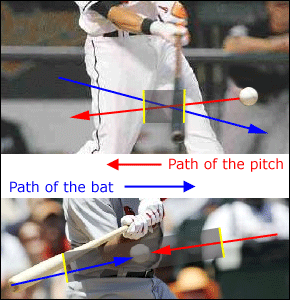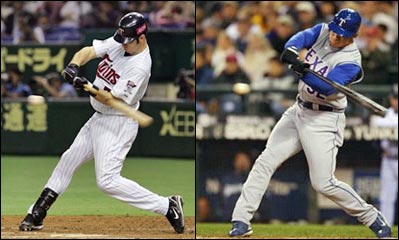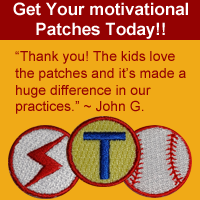Hitting - Arms and Hands
Introduction
We've covered that we want are hips to lead our hands and we don't want to start our swing by pulling with are arms, but clearly you can't hit without the use of your arms and hands. So what's the role of our arms and hands as we swing the bat? Let's begin with the arms and then we'll move to the hands. I would like you to think of the swing as your lower body and hips first, then your arms, and finally your hands. That's the order that we want things to fire.
Arms
Lower Arm: The lower arm has two distinct jobs that I want you to understand and work on.
 Guide the arms and bat on the correct path to the ball - The way we guide the bat on the corect path is by taking the knob of the bat and turning it towards the path of the ball. Don't think of taking the knob of the bat directly to the
ball because this will get your hands too far away from your body. Instead think of taking the knob and putting it on the path of the ball as it comes in.
Guide the arms and bat on the correct path to the ball - The way we guide the bat on the corect path is by taking the knob of the bat and turning it towards the path of the ball. Don't think of taking the knob of the bat directly to the
ball because this will get your hands too far away from your body. Instead think of taking the knob and putting it on the path of the ball as it comes in.
You can see in the image on the right by putting your bat on the correct path you increase the area where you are able to make contact. In the bottom image, the hitter can be a little early or a little late and still get good solid contact. In the image on top where the path of the bat is coming down on the ball, you see that the hitting area is much smaller and anything but perfect timing will result in a miss, a pop-up, or a groundout.
Helps increase bat speed and power - The bat should begin to come forward naturally as you drop the heel and begin to fire your hips. Think of your lower arm as something that helps to accelerate your swing as your hands come forward. Resist the urge to pull with your arms from the beginning of the swing.
Upper Arm: The upper arm is important in developing shoulder tilt and keeping your swing short. The key with the upper arm is to have your elbow come through close to your body. So as you begin your swing your back elbow should also begin to tuck in near your body. By keeping your elbow close to your body, the bat will take the shortest path to the ball which will result in a quicker swing.
Bat Drag: Bad
Bat Lag: Good
Lower Hand: Much like the lower arm, the lower hand is used to guide the bat. As the arms come forward we want the lower hand to aid in keeping the knob of the bat pointed toward the baseball. This is important in developing "bat lag". Bat lag is essential for a quick and powerful swing. As the arms come forward the bat head is left behind until the last possible instance, then it's propelled forward by the hands. This creates a tremendous amount of bat speed which will translate into power. You can't get the benefit of that bat speed if your lower hand doesn't guide the knob of that bat towards the path of the ball, keeping the bat head back. In the images below you see Joe Mauer and Justin Hamilton displaying good bat lag as they are beginning to fire their hands to deliver the bat head to the ball. I love these images because with the ball in view you can see how long they have left the bat head back before firing the hands at the last moment before contact.

Upper Hand: The upper hand is used to deliver the bat head to the ball. As the arms come forward and the bat head is left behind, it's the top hand that is used to snap the bat head forward just before contact. In the next image you see two photos of Albert Pujols who in the first image has his bat head trailing behind and in the second image is in the process of firing his hands to deliver the bat head to the ball.
1. Guide the knob of the bat towards the path of the ball with your lower arm and hand.
2. Tuck the elbow of your upper arm close to your body as you swing the bat.
3. Let the bat head lag behind and then deliver it to the baseball with your hands.
Most Recent Blog Posts
Working With Players on Focusing on the Correct Part of the Baseball when Hitting (October 15 2016)
Getting More Accurate Throws From Your Team (April 5 2016)
I just wanted to tell you that the article about coaching your kid was great!
- Jay F.







